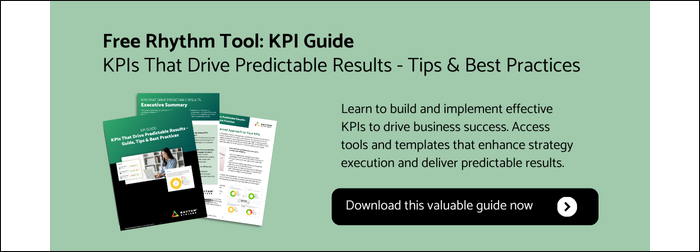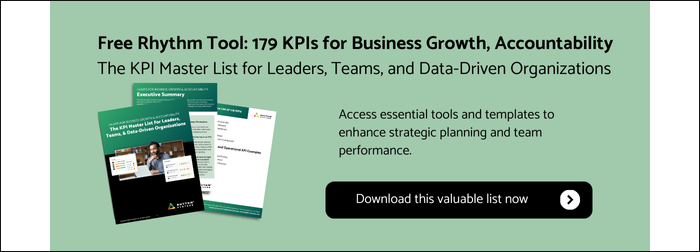3. KPIs to Make Adjustments and Stay on Track
In addition to your current performance, you should monitor your leading indicator KPIs to see how close you are to achieving your goals. These metrics show whether you are on track to reach your desired outcomes. You can then adjust your strategy accordingly. For example, if your sales drop, you may focus more on marketing efforts than product development. Leading indicators have two characteristics: they are measurable, and you can directly influence them. They are good KPIs on your dashboard to keep your projects on track.
4. KPIs to Solve Problems or Tackle Opportunities
Use a combination of KPIs in a dashboard to have the correct information at your fingertips to solve problems or tackle opportunities. Let’s say you are in a sales slump. Identify a handful of KPIs that can help you turn the tide (maybe it is # of outbound calls, # of appointments kept, # of trade shows attended). Put them on a dashboard and track them weekly to see if you’ve found the right lever that helps you generate more predictable sales. Or, let's say you have an excellent idea for a new product. Maybe you test it out with a few clients and use KPIs to validate your business model before launching it on a large scale; you might monitor # of customers interested, $ to support the new product, NPS score, implementation time, # of defects, etc.
5. KPIs to Analyze Patterns Over Time
If you measure the same KPIs quarter over quarter, you can begin to detect patterns in your numbers. There are countless ways these patterns can help you in your business. You can predict your slowest quarter and use that time to do a system update or company-wide training initiative. You can tell that your sales manager always forecasts that you'll come in 5 deals over or under where you usually end the quarter. You can see that you've got some team members who are habitually under-performing or over-performing on their KPIs and can use this data to talk about consequences, bad or good.
An effective KPI dashboard has a mixture of KPIs that follow the balanced scorecard. You want to ensure that you cover all the essential aspects of your business required to monitor your company's progress toward its critical goals and objectives.
Therefore, the top businesses always have at least 2 KPIs (including one leading indicator KPI) from each of the following categories:
- Financial Perspective
- Net Profit
- Net Profit Margin
- Revenue
- Internal Business Perspective (Operational KPIs)
- Revenue Per Employee
- Capacity Utilization
- Customer Perspective
- NPS (Net Promoter Score)
- Repeat Customers
- Employee Perspective
- Employee NPS
- Turnover Rate
To learn more about the importance of KPIs to grow your business, download our free KPI Guide, or check out our list of CEO KPIs.
I know many of you are also using OKRs, which are similar to KPIs. To learn more about the difference, you might be interested in reading OKRs vs. KPIs to ensure that you have the right metrics to help you improve your productivity.
Why are KPIs Important? Watch This KPI Video
Are you looking to create impactful KPIs that align with your business goals and drive your team toward success? Look no further! I've made a short, informative video to walk you through establishing KPIs using the Rhythm Systems methodology. This approach will enable you to track progress effectively and make data-driven decisions that propel your business forward. Take advantage of this opportunity to gain valuable insights and transform your organization's performance. Watch Patrick Thean's video below and embark on your journey towards more meaningful KPIs and a successful business.




